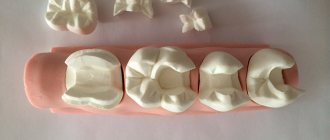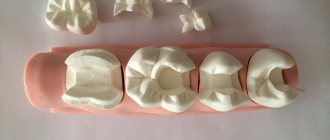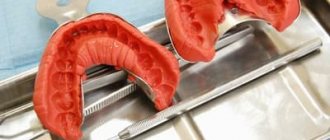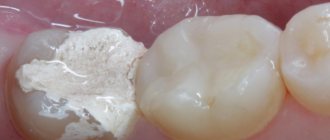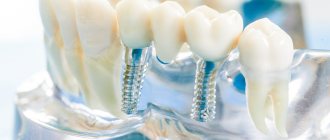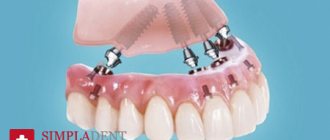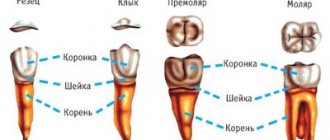In modern dentistry, there are many different methods for restoring damaged teeth - filling, prosthetics, installing inlays. The first two technologies are well known to patients, but few people know that teeth can be successfully restored with inlays.
What are tooth inlays, how do they differ from regular fillings, and in what cases is the use of inlays indicated? We will answer all these questions in detail in this article on our website.
What is it - a tooth tab?
Dental inlays are microprostheses that can be used for different purposes. Restorative or restorative inlays are used like fillings: they help recreate the natural crown of a tooth, keeping it alive. Stump inlays are used in cases where it is necessary to restore a badly damaged tooth under a crown. Let's take a quick look at why restoration and stump inlays are used, and find out the difference between them.
Restoring inlays are stronger than conventional dental fillings and differ from them in the technology of their creation: dental inlays are not made directly in the patient’s mouth, like fillings, but in a dental laboratory, using previously taken impressions. Because microdentures are made in a laboratory setting, they are also called indirect dental inlays.
The inlays exactly repeat the shape of the cavity that needs to be closed for tooth restoration and fit tightly to the natural tissues. The high density of adhesion of the inlay to the tooth tissue eliminates the risk of developing caries in the gap between the installed microprosthesis and the tooth. Restoring a tooth with an inlay will help keep the tooth alive in a situation where a sufficient amount of tooth tissue has been preserved, its nerve is alive and well, but a large filling still needs to be placed. Large fillings do not stick well to the teeth and can break under stress, along with the tooth. Inlays have a long useful life, can withstand chewing loads well, and their use makes it possible not to rush into dental prosthetics with a crown, which often requires preliminary depulpation of teeth.
Stump inlays for a tooth are no longer a restoration element, but a technical one. It acts as a support for the installation of a dental crown in cases where the tooth cannot be restored qualitatively with a conventional filling. In order not to confuse stump and restoration inlays, the easiest way to classify them is as follows: restorative inlays are installed outside the living tooth, stump inlays are always located under the crown.
This is the main classification of inlays, but they can also differ in the type of material they are made of, and below we will definitely talk about all the types of microprostheses and their features. But first, let's find out who and when is recommended to install inlays on teeth.
Dental inlays in dentistry: pros and cons
The advantages here are obvious:
- The design is reliable and durable - it can withstand heavy loads, sits tightly in the gum, does not wear out externally, and the restoration of such a tooth will last more than 12 years;
- Suitable for severely damaged, chipped teeth.
Of the minuses:
- The cost is higher than treatment with structures made of pins and fillings;
- If necessary, a 2- and 3-channel disassembled insert must be installed by a professional who still needs to be found.
Indications for dental restoration with inlays
Let's look at all the cases in which the use of tabs may be indicated. It is recommended to use tabs:
- If the tooth is destroyed by more than 1/3;
- With increased wear of chewing teeth;
- When restoring teeth that in the future will have to act as a support for a crown or installation of a bridge;
- For large carious cavities in the teeth, the elimination of which with conventional fillings is ineffective.
The need to use inlays is determined by the dentist during the examination of the patient. Based on the clinical situation, the specialist will choose the type of microprosthesis that is suitable for you, both in terms of functionality and material of manufacture.
Advantages and disadvantages
Advantages of the tab:
- no predisposition to cracks,
- insensitivity to food colorings,
- copying the tooth shape,
- exact match to the bite,
- maintaining the original appearance regardless of the years that have passed since the installation of the tab,
- giving teeth a natural, finished aesthetic appearance,
- extending the life of natural teeth.
Flaws:
- installation takes more than one hour;
- Prices for inlays are many times more expensive than for fillings.
However, more or less wealthy people who often appear in public are unlikely to refuse inlays if their teeth have become significantly unusable.
Types of restoration dental inlays: description, characteristics
In this section of the article, we will tell you about what restoration dental inlays can be, used in tooth restoration as an alternative to conventional fillings. Prostheses will be classified mainly according to the material of manufacture and according to this criterion, the inlays can be ceramic, composite, or metal. The material of the tooth inlay will affect both the performance characteristics of microprostheses and their cost.
Ceramic tooth inlay and its features
Most often, ceramic dental inlays are used to restore chips on living teeth and act as a high-quality and more reliable alternative to conventional fillings.
Ceramic inlays can only be placed on teeth that are alive, not loose, and have been treated for caries. Ceramic dental inlays have many advantages: they are aesthetically pleasing, durable, do not change their beautiful color even with prolonged use, and do not wear off. The high density of the marginal contact of the ceramic inlay with the natural tissues of the tooth eliminates the risk of developing secondary caries.
But ceramic dental inlays have some disadvantages. Some consider the disadvantages of ceramic inlays for teeth to be the high price of this type of microprosthesis in Moscow (from 8 thousand rubles), however, it should be noted that the high cost is fully justified by the long service life of ceramic inlays and their impeccable aesthetics. Please note that with ceramic inlays installed on your teeth, you will need to give up the habit of chewing nuts, crackers, and other types of too hard foods with your teeth. The ceramic inlay may not withstand such heavy loads!
Metal tooth tab: characteristics, pros, cons
Metal restoration inlays are used quite rarely these days, and all because microprostheses made from this material have a number of disadvantages:
- When installing metal inlays in the mouth, a very unpleasant galvanic side effect for the patient may occur, expressed in constant and profuse salivation, a pronounced metallic taste in the mouth;
- Installing metal inlays does not allow for high-quality and tight contact between the microprosthesis and the natural tissues of the tooth, and this increases the risk of developing secondary caries. Gold inlays on teeth can provide a good fit, but their price will be high, because gold is a noble and expensive metal;
- Metal inserts can cause allergic reactions;
- The aesthetics of metal inlays also leaves much to be desired.
The only significant advantage of metal inlays for teeth is the fairly low price for this type of microprosthesis in Moscow. The cost of a metal tab in the capital’s clinics starts at 4,000 rubles for one orthopedic product.
Composite inlays for teeth
Composite inlays are used to restore single-rooted teeth, which include incisors and canines, that is, the front teeth included in the smile area.
Installation of a composite inlay can only be carried out if the tissue in the tooth being restored is preserved in a volume of at least 50%. Composite inlays are also called pin inlays because when they are placed in the tooth canal, a pin is first placed on which the dentist will apply the composite material in layers. If the tooth is severely damaged, installing an inlay on a pin is not recommended, since over time the pin may begin to wobble in the tooth canal and its mobility can lead to a fracture of the tooth root. If your tooth is more than half destroyed, you do not need a restoration, but a stump inlay followed by installation of a crown!
How much will a composite tooth inlay cost? The answer to this question will depend on what type of post and composite material the dentist uses during the restoration process.
The price of a restoration insert will also depend on the method of its manufacture. All inlays, except composite ones, are created in the laboratory using dental impressions. The tooth for the inlay must be ground down, although the volume of tissue removed will be less than the amount of dental tissue that is removed for the crown. The most complex manufacturing technology is for ceramic crowns, which are made from pressed ceramics: they are created using CAD/CAM computer technology. The complexity of the technology increases the price of ceramic inlays, but such microprostheses will have high anatomical accuracy, which means they will last longer.
Which metal is better?
The selection of the material from which the dental inlay will be made is carried out for several main reasons. It is necessary to decide which crowns the specialist will make in order to restore the teeth to their previous appearance and function.
Metal or metal ceramics are made from a cobalt-chromium alloy.
Alloys of noble metals (gold, platinum, etc.) are placed under the ceramics, or a layer of the same alloy is coated with ceramics or zirconium oxide. A gold inlay for a tooth crown has the best characteristics.
Titanium does not react with biological environments, but it is not as ductile as gold - it breaks under frequent intense stress.
Inlays made of palladium and silver kill microbes due to the latter's ions. However, silver itself is significantly oxidized - it has the ability to stain the gum itself.
Increased hardness and reduced shrinkage are observed only in conventional alloys based on chromium, nickel and cobalt. All three metals are used in industry for good reason – as alloying additives for steel. After all, one of the budget options is stainless steel teeth.
How are restoration inlays installed on teeth?
Installing a restorative inlay on teeth is a multi-step process that always begins with a detailed diagnosis, which will include examination, radiography and computed tomography. After the diagnosis, the type of inlay is selected and a detailed treatment plan is drawn up.
The tooth on which the inlay is planned to be placed is ground down and then an impression is taken from it and sent to a dental laboratory. An inlay will be made based on the impression and the average production time is 5-7 days.
When the inlay is ready, the patient is invited to the clinic for fitting and installation of a microprosthesis. The inlay is fixed in the tooth cavity using special dental cement.
Installation procedure
The inlay is installed into the tooth in several stages.
- First, the condition of the teeth is checked and an impression is made. Creating a finished tooth takes up to two weeks. At this time, a temporary tab is placed.
- Then the newly made inlay is adjusted to the size of the damaged tooth. It should fit completely onto the affected tooth. Then its perfect fit is checked. The doctor administers an anesthetic to the patient, and the tooth is fixed. The inlay is attached to the tooth with dental cement or glue, then it is ground down.
If the patient carefully monitors the condition of his teeth and regularly cleans his mouth of food debris, the inlay’s validity period reaches 10 years.
Is it possible to put an inlay on the front teeth?
Inlays are not used for the restoration of anterior teeth. If there is a sufficient amount of healthy tooth tissue, the tooth is restored with a regular filling and then a veneer or lumineer can be placed on it to obtain a beautiful aesthetic restoration in the smile area. If the tooth is severely damaged, then it makes sense to install a stump tab and then a crown.
The traditional area of application for restoration inlays is chewing teeth.
A crown with an inlay fell out: what to do?
The loss of an inlay with a crown is a consequence of poor tooth installation technology. After inserting the core tab, you need to wait at least a day before grinding it using a dental grinder. If you start almost immediately, without delaying the last, third stage - adjustment - you can displace or even break the adhesive or cement joint.
If the inlay falls out along with the crown, immediately contact your dentist so that he can carry out the fixation procedure again.
Can a tooth get sick under an inlay and what to do if this happens?
If the tooth under the inlay hurts, you need to urgently contact a dental clinic, because pain under the installed microprosthesis can indicate the development of various kinds of complications. The main cause of complications after installing an inlay is medical errors that were made during the treatment process, and that is why it is so important to choose dentistry carefully! If, when treating a tooth, the doctor allows the pulp to overheat, an inflammatory process may begin, as a result of which the tooth under the tab will become sore. To eliminate pulpitis, you will have to remove the tooth inlay, receive appropriate treatment, and then restore the tooth again, possibly with a prosthetic crown or even implantation.
Inlays are often placed on teeth after caries treatment and it is extremely important that when working with a carious cavity, the dentist removes all destroyed tissue. If this is not done, secondary caries will begin under the tab, the treatment of which will again require removal of the tab.
Remember that if 5-7 days have passed after installing the inlay on the tooth, and your tooth hurts and the intensity of the pain is increasing, you need to urgently see a dentist, and not try to solve the problem yourself! If the infection gets into the root part of the tooth, it is not always possible to save the tooth and avoid its removal!
If the tooth does not hurt, but you have the feeling that it is bothering you - when eating, talking, trying to close your teeth - contact the clinic where you received the inlay to have its size corrected.
What types of crowns are there?
Metal-ceramic crown
A metal-ceramic crown is one of the options for dental prosthetics, but at the moment it is inferior in its properties to modern materials.
Metal-ceramic crowns consist of a dense solid-cast frame made of metal (alloys of cobalt and chromium, chromium and nickel or noble metals: platinum, gold, palladium) with a ceramic coating.
A metal-ceramic crown involves significant processing of the tooth, since the metal frame has a thickness of up to 0.5 mm, and the ceramic coating is up to 1.5 mm. Despite the thickness of the ceramic coating, the color of the metal shows through, which makes such a restoration noticeable next to a healthy tooth. Metal can also cause allergies.
Zirconium dioxide crown
Crowns based on zirconium dioxide are available on the basis of a zirconium dioxide frame with the application of ceramic mass, as well as full-form restorations made of zirconium dioxide without the application of ceramics. There are no differences in strength.
Benefits of a zirconium crown
Zirconium dioxide is a material that can withstand very high temperatures and fairly strong impacts. It has high density and strength. Therefore, today zirconium dioxide is considered the most durable material.
Another positive property is that this type of structure is hypoallergenic and lightweight compared to metal frames.
What is very important is that this type of prosthetics makes it possible to preserve a larger volume of tissue when treating teeth, since it is not necessary to create such thick frames in order to obtain the appropriate strength of the restoration.
Metal-free restorations have aesthetics that are very close to natural due to the properties of light transmission and light refraction, therefore zirconium crowns are close in properties to natural enamel and dentin.
All-ceramic crown
All-ceramic restorations are mainly used to veneer anterior teeth or restore a small area using an inlay. To restore the function of lateral teeth, zirconium crowns are mainly used, since they are the strongest at the moment and meet high aesthetic requirements.
Restoration using an all-ceramic crown (also called a double-sided veneer or 360' veneer) is relevant when changing the aesthetic appearance of a tooth with a small area of treatment.
Stump inlays: what do you need to know about them?
At the very beginning of our article, we said that stump inlays should not be confused with restorative microprostheses - they are used to restore pulpless and severely damaged teeth, in which they will serve as the basis for installing a crown or dental bridge.
Stump inlays are structures consisting of two parts: a pin installed in the root canal and a support on which the crown will be fixed. Stump inlays can be monolithic or collapsible, and most often this type of structure is used when the tooth has less than 50% of healthy tissue left.
Many people are interested in the question: why is it best to use core inlays rather than fillings on a pin to restore severely damaged teeth? The fact is that the pin may not withstand the load and begin to wobble in the canal, and this will either lead to the filling breaking or falling out, or, worst of all, to damage to the tooth root, in which the tooth is most often removed. Stump inlays allow you to avoid such risks because they distribute the load more correctly and themselves have much greater strength compared to pins.
Stump inlays are also made in the laboratory and the construction material is selected to match the type of dental crown that is planned to be placed in the future. Metal core inlays are used for metal-ceramic crowns, and zirconium inlays are used for ceramic crowns. If you make a metal inlay for a ceramic crown, it can shine through the thin and transparent material of the crown, which will have a bad effect on the aesthetics of the restoration.
Tooth restoration using a core inlay will also be divided into several stages: diagnostics, preparation, during which a cavity is formed in the tooth for the inlay, manufacturing of the inlay, and its installation. After installing the core tab, the crown is fixed on it and this completes the process of tooth restoration.
If the tooth is destroyed, but there is a living nerve in it, before installing the stump tab, depulpation is carried out, as well as treatment and filling of the root canals. It is important that these procedures are carried out without errors, since poor canal processing leads to various kinds of complications, the elimination of which requires complex and lengthy treatment.
Types of dental prosthetics
Today, the difference between the concepts of crowns, inlays, onlays and veneers has been greatly erased. All of the listed types of restorations are manufactured according to the same protocols using the same technologies and are fixed in the same way, so doctors often call all this a general term - adhesive restorations .
The use of certain prosthetic or restoration methods depends on the specific clinical situation and indications. The orthopedic doctor takes into account the patient’s characteristics, muscle structure and tension, and type of chewing. There is a lot to consider when making a decision. Therefore, it is impossible to say unequivocally: “If such a part of the tooth is destroyed, this is the inlay; the larger part of the tooth is the crown.”
Types of adhesive restorations: crowns, inlays, onlays
There are always half measures. For example, in one case we understand that functionally we can get by with an onlay, but from an aesthetic point of view we would like to increase the area, change the shape, color - in this case we get almost a half-crown.
The most important thing in dental prosthetics is a detailed discussion of options with the patient, careful treatment planning and accurate modeling of structures. The main advantage of orthopedic dental restoration is that it is possible, so the treatment result is precise and durable.
Tab lifespan
The service life of restoration inlays will depend on the material and production technology of microprostheses, as well as on how accurately the patient follows the dentist’s recommendations. Composite inlays last about 5-7 years, ceramic inlays - up to 20 years. This is subject to high-quality dental and oral hygiene and regular visits to the clinic for preventive examinations.
Stump inlays can last you a lifetime, and crowns on them last up to 15-20 years.
Do you still have questions about restorative and core dental inlays? Ask them to the orthopedists of our dentistry in Moscow - Vanstom! You can make an appointment with the clinic’s doctors at any time convenient for you - through the chat on our website, the call back form, or simply by dialing the contact phone number!
Price
Let's consider the average cost of ceramic inlays in Moscow, depending on the material they are made of. The table also shows the advantages and disadvantages of each type of product.
| Material | Price | pros | Minuses |
| Metal based ceramics | 10-15 thousand rubles. | Increased strength due to the inclusion of a metal frame | High risk of falling out of the mouth |
| Pressed ceramics | 15-20 thousand rubles. | Relative strength, high aesthetic characteristics, long service life | Risk of chipping |
| Zirconium dioxide | 25-30 thousand rubles. | Natural appearance, service life up to 20 years | High price |
In the course of life, people often encounter the appearance of chips and cracks in their teeth. Ceramic inlays, which have undeniable advantages over the traditional filling procedure, will allow you to restore the aesthetics of the element. After the treatment, the patient will not need to comply with special conditions for oral care.
What are the advantages of metal inlays?
Most often, gold of 900 purity and higher is used, which is durable, chemically neutral, and malleable when molded. Due to its softness, this metal completely fills the prepared space, preventing the formation of large gaps. As a result, the gold inlay lasts a very long time. It does not oxidize in the mouth, which means it is not harmful to health.
Gold is an expensive material, so many people choose cobalt-chromium alloy. Tabs made from it are less reliable and attractive, but are affordable. To improve the appearance of cobalt chrome dentures, the metal surface is polished to a shine.
